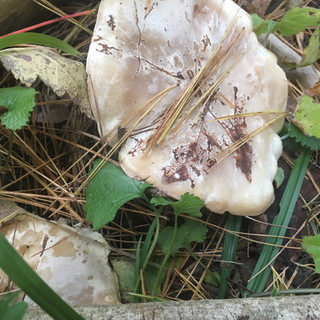Beauty and Curiosity
- The Teachers
- Nov 4, 2018
- 3 min read
I was struck a few year ago when I asked the children to collect beautiful leaves how many of the ones they picked had holes or spots or lumps. These "less than perfect" leaves peaked their curiosity about the anomalies, and those differences were part of why they found them beautiful. It was a reminder for me to look closer and see the beauty in the variations.
Rachel's PreK Reflections
Beauty, curiosity, and peacefulness are all qualities we treasure in our Preschool program, and also ones that Mother Earth provides for us daily. We spend much of our time outdoors (please remember to send rain gear AND winter gear depending on that day’s weather right now!), hiking, exploring, playing, and learning. On one of our hikes this last week, we made an effort to find visual treasures that we could photograph for the blog. As you can see from the images, the children placed a high value on things that evoked curiosity. The rotting mushrooms were the biggest hit! We saw things that were beautiful (the flower that’s still blooming), that were interesting (all the mushrooms), and that caused us to wonder and become researchers (did you recognize that scat as being from a raccoon?). The habits we form in early childhood can set a solid foundation for the rest of our life, and we are thankful to facilitate an appreciation for beauty and discoveries in nature on a daily basis—for as Rachel Carson said, “those who contemplate the beauty of the earth find reserves of strength that will endure as long as life lasts.”
Our Theme: Physics
I love watching the lightbulb ding that comes when an idea clarifies for a child. We did a demonstration about Newton's First Law this week using eggs. Theresa and I each spun a hardboiled egg on the table, stopped it with a finger, and then took our finger off. We did the same procedure with a raw egg. "It's spinning again!" was the cry up and down the table. "That's because it's a liquid, and the liquid is still spinning even though the shell stopped!" An object in motion stays in motion unless acted on by an outside force - they all have a clear image to make that idea more concrete. We compared the forces made by objects with different masses by making craters in a pan of flour. We read The Thrills and Chills of Amusement Parks to find some more real life examples of Newton's Laws of Motion.
We also learned about three of the states of matter: solid, liquid, and gas. We experimented with ways to turn a solid (ice) into a liquid (water) and discovered that some methods worked more quickly than others. We noted how the gas in a bottle topped with a balloon changed in various temperatures and practiced a poem about how molecules move faster and take up more space as they get warmer.
Walt Whitman
Helping children to appreciate poetry can be approached from different places, but one of my favorite ways is to share favorite poems. We read "Miracles" by Walt Whitman and talked about the moments of beauty in our everyday lives. The youngest children read it again with Rachel. The bigger children each picked a favorite line or two to write and illustrate. Some of the favorite lines included "stars shining so quiet and bright," "animals feeding in the fields," and "to me the sea is a continual miracle." Watching Walt Whitman's words work on the group, prompted more than one person to get chills.
The beauty of our natural world, science, and poetry all came to light this week, and all of it was shaped by curiosity.










































Comments